An unexpected – and unwanted - visitor: Hurricane Lidia
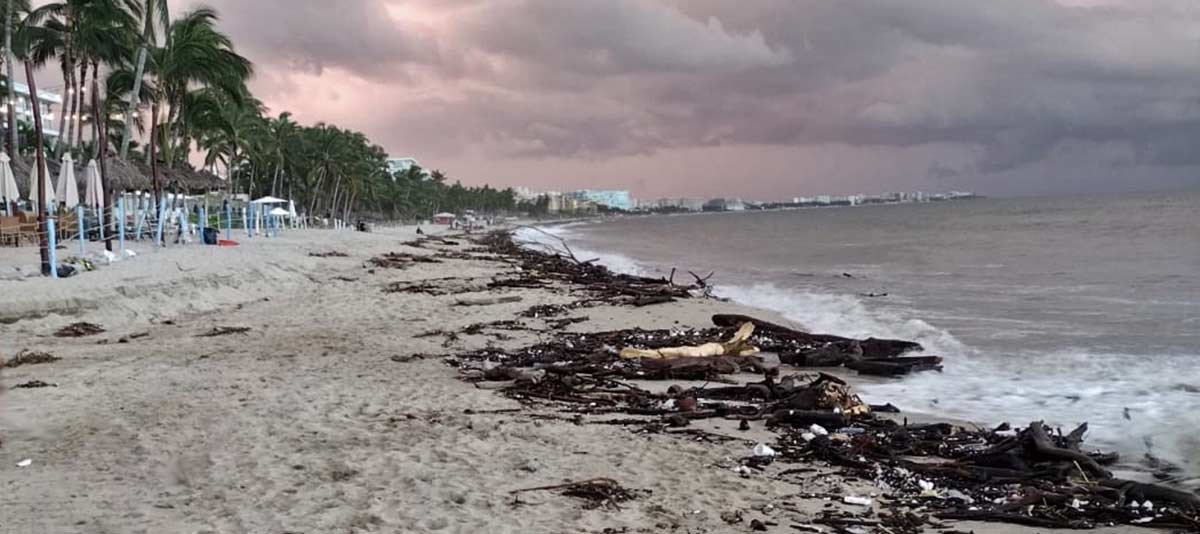
On Tuesday 10th October, Hurricane Lidia hit Puerto Vallarta and Bucerias! When we decided to spend October in Puerto Vallarta, we expected rain in the afternoons, along with high temperatures. The hurricane was an unwelcome surprise!
As we drove around early on Tuesday, we saw a few shops boarding up their windows but took little notice. Later, we got a message from our Airbnb landlady warning us of the impending arrival of Hurricane Lidia. She told us the authorities said they were going to cut the water supply to the houses as a safety precaution. We were also warned the storm would affect the electric power supply.
As things turned out, when Hurricane Lidia hit Puerto Vallarta it created many more problems!
Confusion about when and where would Hurricane Lidia strike
For a few days previously, news reports had mentioned Hurricane Lidia. But most of the reports were unsure of its strength and even where it would land. Many said it would be a low-strength hurricane which would make landfall over 100 miles (160 km) south of the city.
Late on Tuesday evening, Hurricane Lidia made landfall on Cabo Corrientes. This is the peninsula that juts out into the Pacific Ocean about 50 miles (80 km) to the south. To everyone’s surprise, the hurricane had moved north and strengthened from a category 2 hurricane into a category 4 hurricane. Winds of 140 mph (220 kph) struck Puerto Vallarta, causing significant damage. Bucerias is a little further north along the coast and suffered slightly weaker winds.
Both towns suffered from severe flooding, with as much as 12 inches of rain forecast.
Hurricane Lidia has a terrible impact of the Banderias Bay area.
Sadly, reports said a falling tree killed one person, while another drowned in the floods. Debris and broken glass thrown about by the winds injured several people.
The damage to both Puerto Vallarta and Bucerias was worse than expected. The hurricane winds blew down many trees and damaged properties across the Bay area. A friend of ours in Bucerias had a tree fall on her house.
Parts of the famous Puerto Vallarta Malecon were closed off the following morning due to damage and debris from fallen trees.
Boca de Tomatlán is a well-known departure point for water taxis to bays like Yelapa. Unfortunately, being further south than Puerto Vallarta and closer to the hurricane’s landfall, heavy rains triggered a landslide. This cut the town off from the city and has caused shortages of water and food.
In Mezcalles, we were mostly protected by the buildings around us. The wind was strong but caused little damage, aside from felling trees. The roof on the house next to us was not fixed properly and banged incessantly and loudly for several hours until the storm passed.
When I checked our car for damage the next morning, I found part of someone’s roof jammed under the front wheel. (The car was otherwise unscathed!)
Power and Internet
For many, the biggest challenge has been the lack of power. We were cut off for 7 hours on Tuesday night. But our water was never cut off. However, even as late as Monday 16th October – 6 days after the hurricane barreled through the area, many people are still without power and have no Internet.
For us, the Telcel phone service was non-existent for 3 days, only starting in bursts on Friday.
The Pacific Ocean reveals some of the devastation
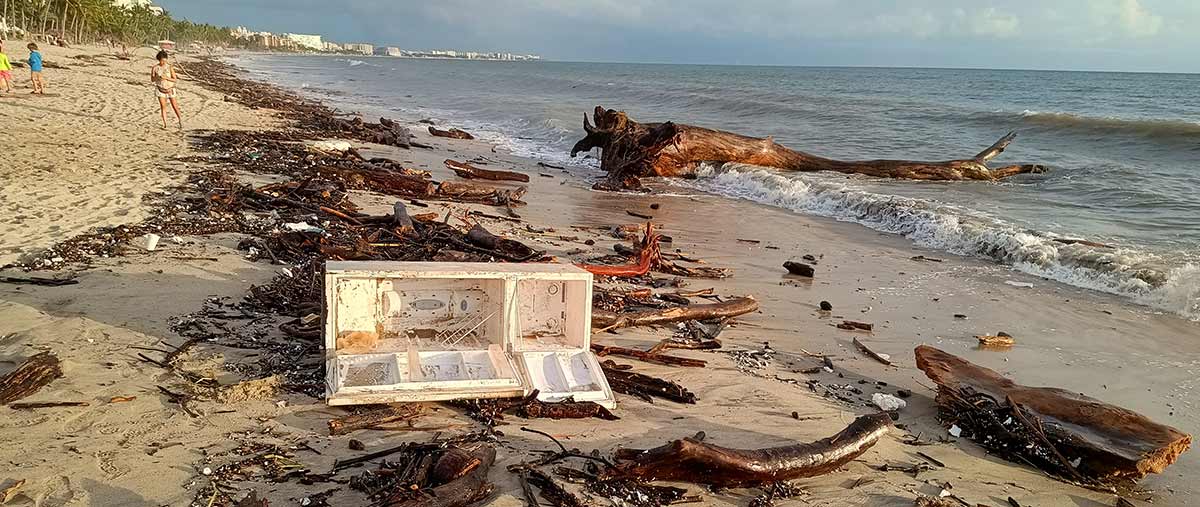
The beaches of Bucerias are deservedly known for their white sand and lovely water. The day after Hurricane Lidia, the beaches were far less inviting.
The storm had brought in a huge amount of flotsam and jetsam, mainly branches and even several full-size trees. We were surprised to see one complete fridge and the door of a second one lying in the surf, mixed up in the debris (Who throws fridges into the sea?)
By the next morning, most of the tree debris had been scraped into piles, although the large trees remained. Even a week later, parts of the beach in Bucerias are still covered in logs and broken branches.
Karen’s Place and many other establishments along the Bucerias beach front spent the day after the storm putting their lights and umbrellas back up.
It was a shame to see one of the beach vendors was sitting stoically selling on a stool his jewelry. The day before he had been in a full-size tent from which he sold his wares. It was blown away in the storm.
Photos of Damage caused when Hurricane Lidia hit Puerto Vallarta
The damage caused by the strong winds and rain from the Hurricane Lidia was felt across the Banderas Bay area.
Some of it was fairly superficial, whilst other damage was more long lasting. Power to some areas was not properly restored for over a week after the storm hit.
We were in Mezcales (which has abysmal Internet at the best of times) and we lost Internet for several days directly after the storm and then on and off for days at a time for 12 days.
The photo below shows the Malecon at Puerto Vallarta a few days after the storm hit. The huge waves were still causing problems, tossing large rocks like pebbles onto the Malecon.
We were told that the last big hurricane sent waves across the Malecon that smashed the windows of various jewellers and dragged their stock into the ocean. Apparently, that led to a sudden interest in beach-combing!
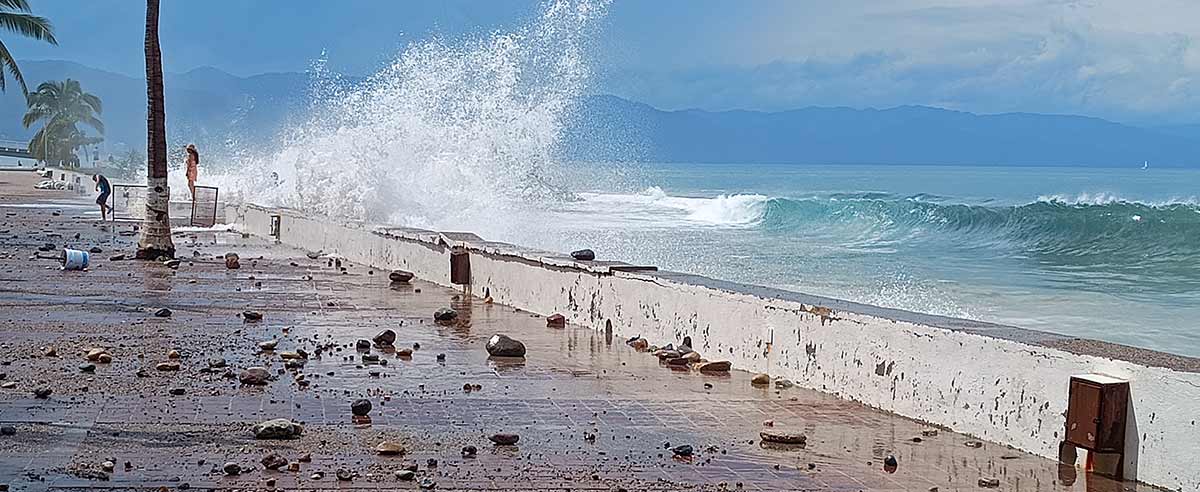
Many trees were brought down, both in Puerto Vallarta and Bucerias. One of our friends was woken to the sound of a large tree toppling onto the roof of her house.
Across Puerto Vallarta, extreme flooding was a big problem. This was exacerbated by the state of the roads. Many roads have large potholes – when you’re driving through water 6″ deep they are hard to avoid!
Trees pulled down power lines and, sadly, were responsible for injuries and fatalities.
Near the Fredy Toucan Fluvial restaurant, this lamp took a direct hit from a large toppled tree.
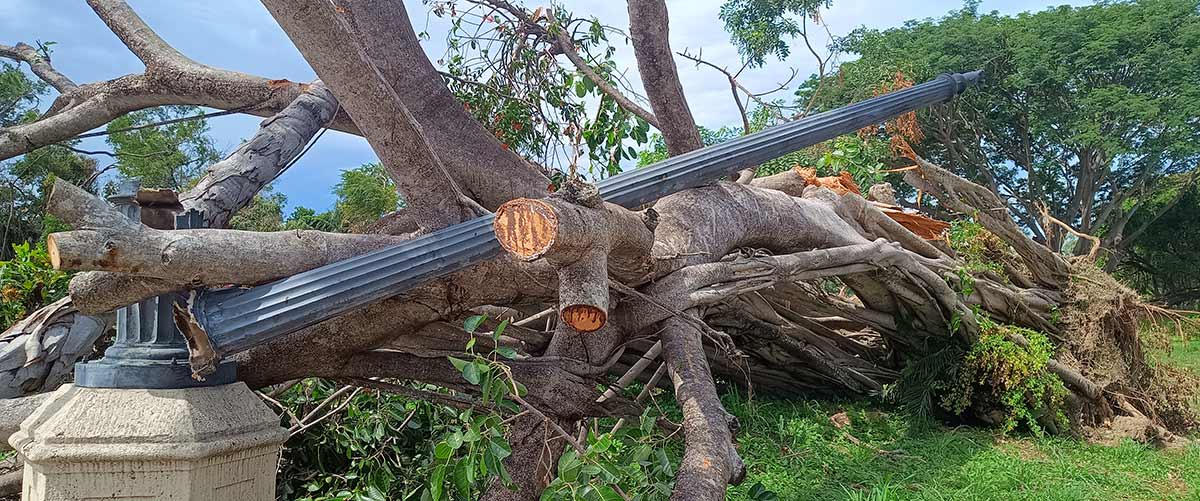
Bucerias lost its R during the Hurricane!
Although not hit directly, Bucerias felt the force of the winds.
The iconic Bucerias letters lost their R. I was not able to find out where it went!
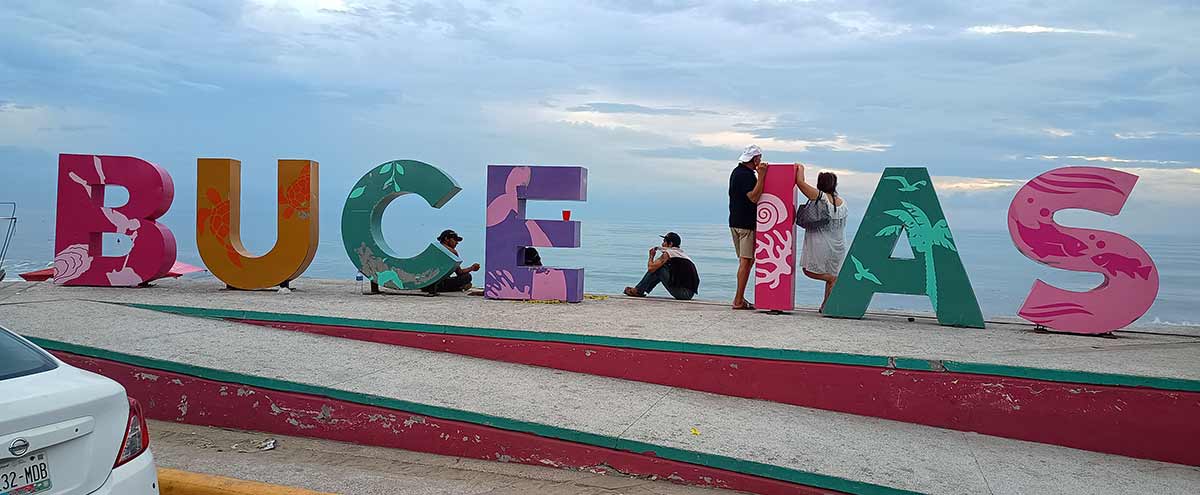
Mariposario Jardin Magico – the Puerto Vallarta Butterfly Sanctuary
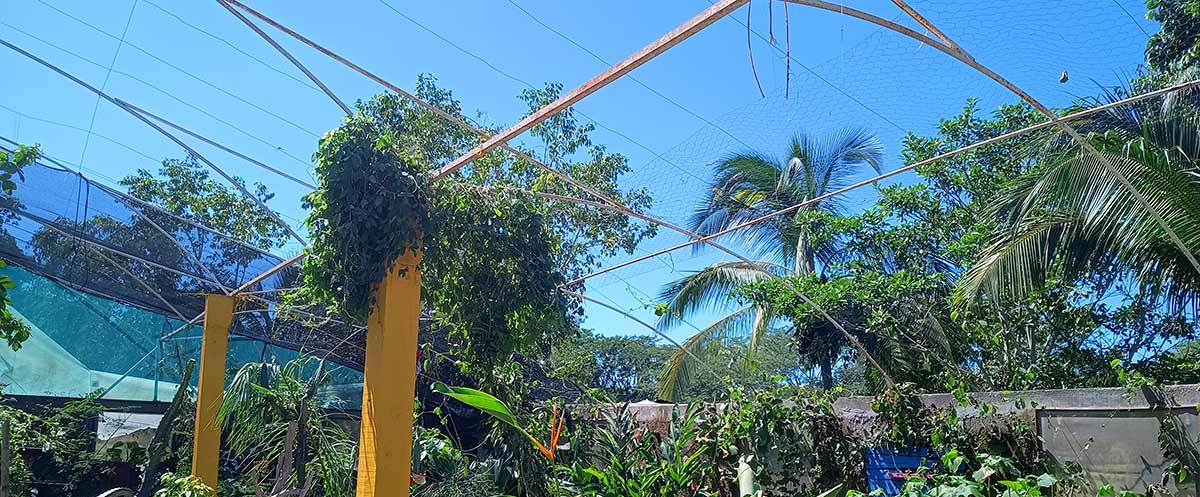
Unaware of the extent of the hurricane damage, we went to the Butterfly Sanctuary also known as Mariposario Jardin Magico which is just outside Puerto Vallarta.
When we arrived it was very quiet, with no one about. After walking around to find someone, we met Fabian the owner. Fabian apologized profusely for our wasted journey – the Sanctuary was temporarily closed. He only had to open the door for it to become obvious why. There was no roof!
The storm winds had ripped the roof right off.
However, Fabian and a band of enthusiasts were working very hard to get everything fixed and back on track by 20th October.
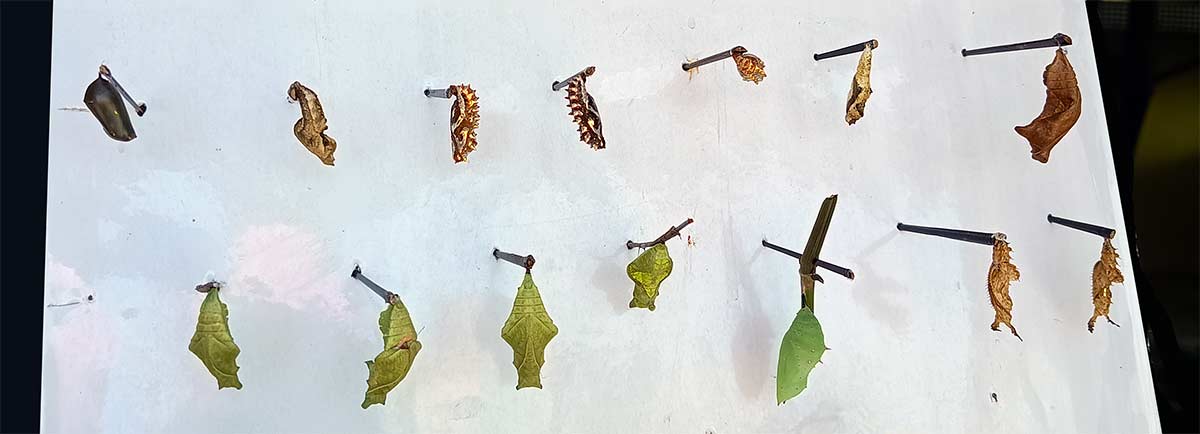
Despite the lack of a roof due to the storm, there were still a good number of butterflies enjoying the many flowers and plants that survived.
Fabian was a great host and, despite the chaos around us, delighted in showing us larvae and pupae, explaining which food plants were being used by each species. It was a fabulous couple of hours.
We have every intention of returning to see the Butterfly Sanctuary operating a full strength.
Should Hurricanes stop you from visiting Puerto Vallarta?
There are many reasons to visit Puerto Vallarta and Bucerias in the off-season (August through to October). The beaches are empty, the crowds are missing and accommodation is normally cheaper.
One of the downsides is the weather. This is the rainy season. And when it rains, it does so with enthusiasm! Roads get flooded and the beaches can lose their pristine white sandy appearance.
But, for the most part, the mornings are sunny with rain normally only arriving in the late afternoon. However, when storms occur, the rainy periods may be longer and the sunny ones shorter.
It’s also hot. These three months are the hottest and most humid of the year.
Hurricane Otis strikes Acapulco
A few days after Hurricane Lidia hit Puerto Vallarta, Hurricane Otis struck Acapulco with devastating consequences. The damage and loss of life were terrible.
Otis was a category 5 hurricane, whereas Lidia was category 4. Acapulco is over 400 miles (700 km) south of Puerto Vallarta.
What does this mean for your holiday? Should you avoid the Pacific Coast, specifically Puerto Vallarta because of the risk of hurricanes?
That’s a choice you will have to make.
An important difference between Acapulco and Puerto Vallarta is that the latter is in a protected bay. Hurricane Lidia hit the peninsula at Cabo Corrientes, so it had lost some of its strength before it hit the city.
Hurricanes are rare!
Hurricanes? They shouldn’t put you off. When Hurricane Lidia hit Puerto Vallarta it was a rare event. It was bad but for most holiday-makers, the hotels work hard to minimize the impact. The authorities are aware of the importance of tourist dollars, so they also work hard to ensure tourist areas are cleared quickly.
The last notable hurricane to make landfall in this area was Hurricane Patricia, in 2015. That made landfall a long way south of Puerto Vallarta and had minimal impact.
If you don’t mind a bit of rain and warm weather, and prefer few crowds, consider booking now for a great holiday!
Is Puerto Vallarta safe to visit?
Hurricanes aside, a common question I get asked is “Is it safe to visit Puerto Vallarta?”
Nowhere is 100% safe if you don’t exercise common sense. But Puerto Vallarta is, according to the latest Numbeo crime stats for the Americas, the second safest city in Mexico, behind Merida in the Yucatan. And it is twice as safe as Cancun with regard to crime!
You can read more about safety in Mexico here.
Categories:
David H
After spending months in places like Playa del Carmen and Ajijic (near Lake Chapala, Guadalajara), my family and I have been living for the past four years in the Yucatan and enjoying this fabulous part of Mexico.
I've written many travel blogs for other travel sites over the years before starting Wonky Compass. I have three books published on Amazon.
Copyright 2024 www.wonkycompass.com